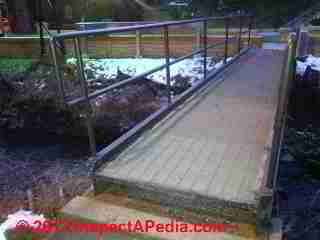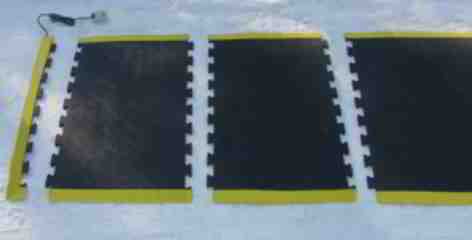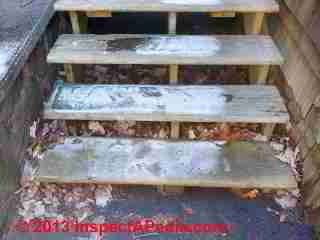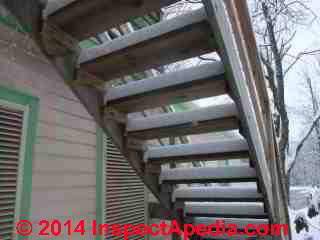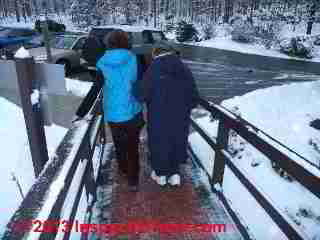 Snow & Ice Removal from Walking Surfaces
Snow & Ice Removal from Walking Surfaces
Approaches to reducing or removing snow & ice from ramps, stairs & walkways
- POST a QUESTION or COMMENT about Algae, Ice, Fungus, Wet Surfaces & Other Stair Slip, Trip & Fall Hazards
Snow & ice fall hazards on exterior stairs, ramps, walkways, & snow & ice removal methods: examples of methods fdor clearing snow and ice from exterior walking surfaces are given followed by research citations on snow & ice contribution to exterior falls on ramps, stairs & walkways.
This article series describes common causes of & cures for slippery walking surfaces on stairs and walkways. We include ramp, stair and walkway maintenance suggestions to reduce slip, trip and fall hazards due to water, algae, snow, ice, etc.
InspectAPedia tolerates no conflicts of interest. We have no relationship with advertisers, products, or services discussed at this website.
- Daniel Friedman, Publisher/Editor/Author - See WHO ARE WE?
How to Reduce Snow & Ice Slip & Fall Hazards on Ramps, Stairs & Walks
Besides the obvious requirements for properly constructed ramps, guardrails, hand-railings, and stairways themselves, building owners & managers use a variety of methods to reduce the falling hazards from snow and ice on ramps, stairs, and walkways, including at least these:
- Build a sheltering roof or enclosure
over and around the walking surface - Design the walking surface to drain properly,
minimizing water accumulation that in turn contributes to algae & ice formation. Proper drainage also reduces algae formation on these surfaces. - Provide more sunlight
on the walking surface by removing shading trees or obstructions. Adding hours of sun will not eliminate snow, ice, or algae slip hazards but will reduce them and may make surface maintenance easier. - Remove accumulated snow and ice -
by shoveling, sweeping, and use of snow and ice melt products such as- Ice melting salts or chemicals
- Heated walking surfaces, provided by building a heating system into stairs, ramps or sidewalks - elaborated below.
- Overhead heating lamps and lights projecting onto walking surfaces
Developments on construction of heated surfaces to melt snow & ice from outdoor walking surfaces include both built-in radiant heating systems in outdoor drives, walks, and stairs and electrically-heated mats or walkways that can be placed on stairs and walkways.
- Built-in heated sidewalks & stairs:
New York City (and possibly other) sidewalks have been reconstructed with built-in heating tubing (RADIANT HEAT) in front of some buildings - a feature claimed by marketers and owners as a selling feature at some office buildings and condominiums
Add-on heated walking surfaces:
several companies listed below provide systems for add-on electrically heated mats or walking surfaces that can be place on outdoor stairs, ramps, or walkways likely to otherwise accumiulate slippery snow and ice.
- Clear Path heated walkway surface
add-on: In June 2014 we were contacted by Fundable.com seeking crowd-funding support for Clear Path, a company seeking funding for an insulated electrically-heated walking surface (illustration above) that claims to significantly reduce the electrical energy required to heat an outdoor surface to melt away snow and ice. Interested readers can see this link seeking product funding:
http://www.fundable.com/ClearPath
Notice: InspectAPedia.com is an independent publisher of building, environmental, and forensic inspection, diagnosis, and repair information provided free to the public - we have no business nor financial connection with any manufacturer or service provider discussed at our website.
Other companies offering products for heating walking surfaces & snow melting products used on ramps, stairs, walkways include - HeatTrak snow melting mats,
US & CANADA HeatTrak LLC 3641 Clearview Parkway Doraville, GA 30340 Toll Free: (888) 586-4904
Europe and Scandinavia Dia Proff Norge AS Tel: (+47) 67 06 73 30 Fax: (+47) 67 06 73 31 Dir: (+47) 45 00 00 00 Adresse: Kjeller vest 3, 2007 Kjeller post@diaproff. Email: info@heattrak.com, Website: http://www.heattrak.com/, retrieved 6/23/2014, original source; http://www.heattrak.com/ - KeMF HeatFlake heated rubber doormats
EMF, 2102 Victoria Avenue, Greenfield Park, Québec, Canada J4V 1M9 Main: 450-923-4812 Toll-free Canada: 1 866-923-4812 Toll-free USA: 1 855-468-0088 Fax: 450-923-8890 info@kemf.ca, Website: retrieved 6/23/2014, original source: http://kemf.net/hotflake-heated-mat/
Research Confirms that Snow & Ice on Exterior Ramps, Stairs, or Walks is a Serious Fall & Injury Hazard
Failure to keep exterior walking surfaces free of ice and snow is discussed extensively in literature on fall hazards in climates where freezing conditions occur. Some particularly helpful research citations on snow and ice slip trip and fall hazards are given just below.
At SNOW & ICE on WALKING SURFACES we include data on the slipperiness of ice and snow covered surfaces including the static coefficient of friction used to measure just how slippery such surfaces are.
You'll see that water on ice is extremely slippery as is "black ice" on surfaces.
Snow and ice may cause or contribute to very serious falls and falls that may be witnessed by more people - as the walker is outdoors - than indoor slips, trips and falls that may occur where the field of view for second-party observers is more limited.
However, among these research citations, Strandberg et als. offers data making clear that claims of injury statistics related to falls in which snow and ice played a key role is smaller than that claimed by some of the de-icing industry product manufacturers.
Research on Slip & Fall Hazards Involving Ice or Snow
Most falls occur indoors while only about 13-15% of fall injuries cite snow and ice as a factor.
Sheldon (1960) found up to 50% of falls they studied involved ice and snow, and El Faizy notes further that snow and ice factors have been omitted on some surveys of home fall inury studies! - Sheldon (1960), Sjörgen (1991), Strandberg (1981), El-Faizy (1994).
- Abeysekera, J., and Z. Khan. "Slipping and falling accidents on icy surfaces: a case study from northern Sweden." ARBETE OCH HALSA VETENSKAPLIG SKRIFTSERIE (1998): 201-204.
- Bentley, Tim. "The role of latent and active failures in workplace slips, trips and falls: An information processing approach." Applied ergonomics 40, no. 2 (2009): 175-180.
- Bentley, Tim A., and R. A. Haslam. "Identification of risk factors and countermeasures for slip, trip and fall accidents during the delivery of mail." Applied ergonomics 32, no. 2 (2001): 127-134.
- El-Faizy, Marjan, and Sibylle Reinsch. "Home safety intervention for the prevention of falls." Physical & Occupational Therapy in Geriatrics 12, no. 3 (1994): 33-49.
- Gao, Chuansi, and John Abeysekera. "The assessment of the integration of slip resistance, thermal insulation and wearability of footwear on icy surfaces." Safety science 40, no. 7 (2002): 613-624.
- Haslam, R. A., and Tim A. Bentley. "Follow-up investigations of slip, trip and fall accidents among postal delivery workers." Safety Science 32, no. 1 (1999): 33-47.
- Kemmlert, Kristina, and Lotta Lundholm. "Slips, trips and falls in different work groups—with reference to age and from a preventive perspective." Applied ergonomics 32, no. 2 (2001): 149-153.
- Marietta, William. "Trip, slip and fall prevention." The Work Environment: Occupational Health Fundamentals 1 (1991): 241.
- Pynoos, Jon, D. Sabata, and I. H. Choi. "The role of the environment in fall prevention at home and in the community." Falls free: Promoting a national falls prevention action plan (2005): 41-54.
- Ryerson, Charles C. "Ice protection of offshore platforms." Cold Regions Science and Technology 65, no. 1 (2011): 97-110.
- Sheldon, J. H. "On the natural history of falls in old age." British Medical Journal 2, no. 5214 (1960): 1685.
- Sjörgen, Harmeet, and Ulf Björnstig. "Injuries among the Elderly in the Home Environment Detailed Analysis of Mechanisms and Consequences." Journal of Aging and Health 3, no. 1 (1991): 107-125.
- Strandberg, Lennart. "On accident analysis and slip-resistance measurement." Ergonomics 26, no. 1 (1983): 11-32.
- Strandberg, Lennart, and Håkan Lanshammar. "The dynamics of slipping accidents." Journal of Occupational Accidents 3, no. 3 (1981): 153-162.
...
Continue reading at RAMP SLIP TRIP FALL HAZARDS or select a topic from the closely-related articles below, or see the complete ARTICLE INDEX.
Or see these
Recommended Articles
- SLIP TRIP & FALL HAZARD LIST, STAIRS, FLOORS, WALKS
- SLIPS, TRIPS & FALLS, EXTERIOR STAIRS
- SLIPPERY STAIRS, WALKS, ROOFS
- STAIR CODES & STANDARDS
Suggested citation for this web page
SNOW & ICE REMOVAL on WALKS & STAIRS at InspectApedia.com - online encyclopedia of building & environmental inspection, testing, diagnosis, repair, & problem prevention advice.
Or see this
INDEX to RELATED ARTICLES: ARTICLE INDEX to STAIRS RAILINGS LANDINGS RAMPS
Or use the SEARCH BOX found below to Ask a Question or Search InspectApedia
Ask a Question or Search InspectApedia
Try the search box just below, or if you prefer, post a question or comment in the Comments box below and we will respond promptly.
Search the InspectApedia website
Note: appearance of your Comment below may be delayed: if your comment contains an image, photograph, web link, or text that looks to the software as if it might be a web link, your posting will appear after it has been approved by a moderator. Apologies for the delay.
Only one image can be added per comment but you can post as many comments, and therefore images, as you like.
You will not receive a notification when a response to your question has been posted.
Please bookmark this page to make it easy for you to check back for our response.
IF above you see "Comment Form is loading comments..." then COMMENT BOX - countable.ca / bawkbox.com IS NOT WORKING.
In any case you are welcome to send an email directly to us at InspectApedia.com at editor@inspectApedia.com
We'll reply to you directly. Please help us help you by noting, in your email, the URL of the InspectApedia page where you wanted to comment.
Citations & References
In addition to any citations in the article above, a full list is available on request.
- ASTM F 1637, Standard Practice for Safe Walking Surfaces, (Similar to the above standard
- [9] Falls and Related Injuries: Slips, Trips, Missteps, and Their Consequences, Lawyers & Judges Publishing, (June 2002), ISBN-10: 0913875430 ISBN-13: 978-0913875438
"Falls in the home and public places are the second leading cause of unintentional injury deaths in the United States, but are overlooked in most literature. This book is unique in that it is entirely devoted to falls. Of use to primary care physicians, nurses, insurance adjusters, architects, writers of building codes, attorneys, or anyone who cares for the elderly, this book will tell you how, why, and when people will likely fall, what most likely will be injured, and how such injuries come about. " - [12] Slips, Trips, Missteps and Their Consequences, Second Edition, Gary M. Bakken, H. Harvey Cohen,A. S. Hyde, Jon R. Abele, ISBN-13: 978-1-933264-01-1 or ISBN 10: 1-933264-01-2, available from the publisher, Lawyers ^ Judges Publishing Company,Inc., www.lawyersandjudges.com sales@lawyersandjudges.com
- [13] Slips, Trips, Missteps and Their Consequences, Gary M. Bakken, H. Harvey Cohen, Jon R. Abele, Alvin S. Hyde, Cindy A. LaRue, Lawyers and Judges Publishing; ISBN-10: 1933264012 ISBN-13: 978-1933264011
- [14] The Stairway Manufacturers' Association, (877) 500-5759, provides a pictorial guide to the stair and railing portion of the International Residential Code. [copy on file as http://www.stairways.org/pdf/2006%20Stair%20IRC%20SCREEN.pdf ] -
- [29] A. Sacher, International Symposium on Slip Resistance: The Interface of Man, Footwear, and Walking Surfaces, Journal of Testing and Evaluation (JTE), ISSN: 1945-7553, January 1997 [more focused on slipperiness of polished surfaces
- [30] Algae is widely recognized as a slippery surface - a Google web search for "how slippery is algae on steps" produced more than 15,000 results on 8/29/12)
- [31] Slipperiness of algae on walking surfaces, warning, Royal Horticultural Society, retrieved 8/29/2012, original source: http://apps.rhs.org.uk/advicesearch/profile.aspx?pid=418
- [32] Slipperiness of algae: "Watch your step, wet rocks and algae are slippery" Oregon State University warning 1977 retrieved 8/29/2012, original source: http://www.worldcat.org/title/watch-your-step-wet-rocks-and-algae-are-slippery/oclc/663683915
- [35] Jason R. Stokes, Lubica Macakova, Agnieszka Chojnicka-Paszun, Cornelis G. de Kruif, and Harmen H. J. de Jongh, "Lubrication, Adsorption, and Rheology of Aqueous Polysaccharide Solutions, Langmuir 2011 27 (7), 3474-3484
- [36] "Coefficients of Friction for Ice", The Physics Factbook™, Glenn Elert, Ed., retrieved 8/29/12, original source: http://hypertextbook.com/facts/2004/GennaAbleman.shtml
- [37] "Coefficients of Friction for Ice", The University of the State of New York Reference Tables for Physical Setting/Physics. New York: The State Education Department, 2002. Op. Cit.
- [38] Serway Physics for Scientists and Engineers 4th edition (p. 126.)
- [39] "How Slippery Is It", retrieved 8/29/12, original source http://www.icebike.org/Articles/howslippery.htm
- [40] John E. Hunter, "Friction Values", The Source, Society of Accident Reconstructionists, Winter 1998. Study of frictional values of car tires involved in collisions on snow or ice covered roadways.
- [41] Frictional Coefficients of some Common Materials and Materials Combinations, The Engineering Toolbox, retrieved 8/29/2012, original source: http://www.engineeringtoolbox.com/friction-coefficients-d_778.html [copy on file as Friction and Coefficients of Friction.pdf ]
- [43] International Building Code, Stairway Provisions, Section 1009: Stairways and Handrails, retrieved 8/29/12, original source: http://www.amezz.com/ibc-stairs-code.htm [copy on file as IBC Stairs Code.pdf]
- [44] Model Building Code, Chapter 10, Means of Egress, retrieved 8/29/12, original source: http://www2.iccsafe.org/states/newjersey/NJ_Building/PDFs/NJ_Bldg_Chapter10.pdf, [copy on file as NJ_Bldg_Chapter10.pdf] adopted, for example by New Jersey. International Code Council, 500 New Jersey Avenue, NW, 6th Floor, Washington, DC 20001, Tel: 800-786-4452
- In addition to citations & references found in this article, see the research citations given at the end of the related articles found at our suggested
CONTINUE READING or RECOMMENDED ARTICLES.
- Carson, Dunlop & Associates Ltd., 120 Carlton Street Suite 407, Toronto ON M5A 4K2. Tel: (416) 964-9415 1-800-268-7070 Email: info@carsondunlop.com. Alan Carson is a past president of ASHI, the American Society of Home Inspectors.
Thanks to Alan Carson and Bob Dunlop, for permission for InspectAPedia to use text excerpts from The HOME REFERENCE BOOK - the Encyclopedia of Homes and to use illustrations from The ILLUSTRATED HOME .
Carson Dunlop Associates provides extensive home inspection education and report writing material. In gratitude we provide links to tsome Carson Dunlop Associates products and services.


